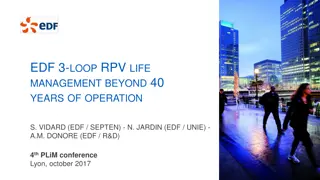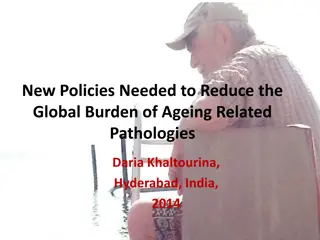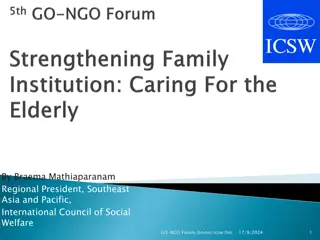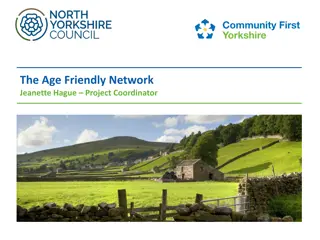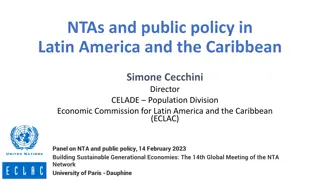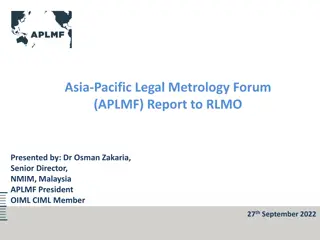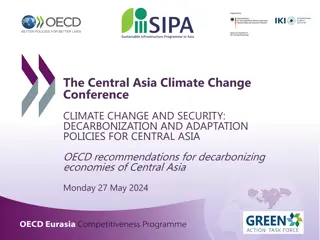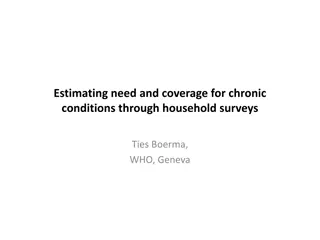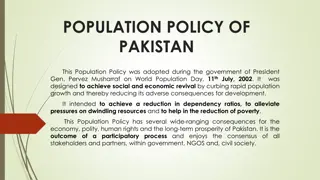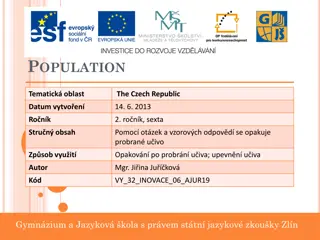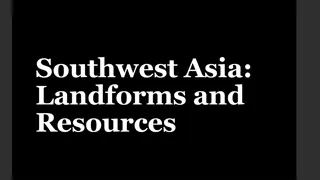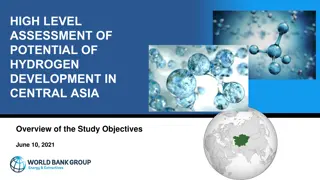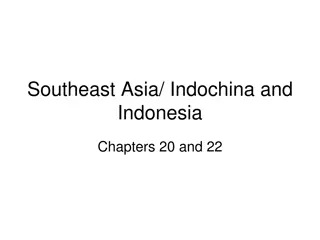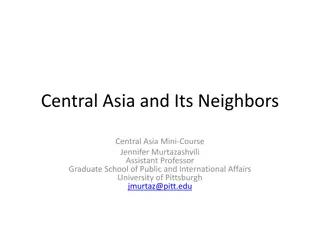Challenges of Population Ageing in Asia
Exploring the process and challenges of population ageing in Asia, this research delves into demographic trends, age-based and percentile-based measures, and the social security implications of an ageing population. The data presented sheds light on the dynamic nature of population ageing and its impact on various regions.
Download Presentation

Please find below an Image/Link to download the presentation.
The content on the website is provided AS IS for your information and personal use only. It may not be sold, licensed, or shared on other websites without obtaining consent from the author. Download presentation by click this link. If you encounter any issues during the download, it is possible that the publisher has removed the file from their server.
E N D
Presentation Transcript
The Process of Population Ageing and Its Challenges in Asia Heather Booth Research School of Social Sciences Australian National University ARC Centre of Excellence in Population Ageing Research Public Lecture, 10 February 2016 The Oxford Institute of Population Ageing
Outline The process of population ageing Measuring population ageing Trends in Asia exploring heterogeneity Challenges social security in old age 2
THE PROCESS OF POPULATION AGEING 3
Population ageing dynamic process G E N E R A T I O N S PROCESS 4
Demographic Transition and Population Ageing Population ageing 5
MEASURING POPULATION AGEING 6
Measures based on age thresholds: 15 & 65 3 AGE-BASED MEASURES Proportion aged 65+ Old-age dependency ratio 65+ / 15-64 Old-age share of dependency 65+ / (65+ & 0-14) 7
Measures based on percentile thresholds: 25, 50, 75 etc PERCENTILE-BASED MEASURES 50% Median age Oldest quartile Youngest quartile 50% 8
TRENDS IN ASIA EXPLORING HETEROGENEITY 9
Population aged 65+ as a percentage of total population, world regions, 1950-2050 Asia Notes: Solid lines are estimates (1950-2010); dashed lines are projections (2011-2050). Source: United Nations (2012) World Population Prospects: 2012 Revision. New York: UN. 10
Age-sex structure of total population of Asia, 1950 and 2010 11
EASTERN ASIA SOUTH-CENTRAL ASIA South Asia SOUTH-EASTERN ASIA WESTERN ASIA Arab China Hong Kong Japan Macao North Korea Mongolia South Korea Taiwan Afghanistan Bangladesh Bhutan India Iran Maldives Nepal Pakistan Brunei Cambodia Indonesia Laos Malaysia Myanmar Philippines Singapore Bahrain Iraq Jordan Kuwait Lebanon Oman Qatar Saudi Arabia Sri Lanka Thailand Palestine Timor-Leste Syria Vietnam United Arab Emirates Yemen Non-Arab Central Asia Kazakhstan Kyrgyzstan Tajikistan Turkmenistan Uzbekistan Armenia Azerbaijan Cyprus Georgia Israel Turkey 13
Indicators of ageing, 1950-2010 Old-age dependency ratio % aged 65+ Old-age share of total dependency Median age 14
% 65+ 15
% 65+ 16
% 65+ 17
% 65+ 18
% 65+ 19
Change in median age 1950-2010 -5-0 0-5 5-10 10-15 15+ 20 years
Old age share of total dependency, 2010 0-10 10-20 20-30 30-40 40+ per 100 21
Old Age Dependency Ratio, 2010 0-10 10-20 20-30 30-40 40+ per 100 22
1950 and 2010 OASD OADR 65+ / 65+ / (15-64) (65+ & 0-14) 23
THE CHALLENGES SOCIAL SECURITY IN OLD AGE 24
Population ageing and the family Intergenerational contract Weakened by demographic transition, population ageing, economic and social change Demography: 4-2-1 problem Economic: working generation squeezed Social: status of women and parental care Adaptation - filial piety maintained 25
Population ageing and the state Old-age social security - slow development and inadequate Contributory social security schemes: Sustainability of defined benefit schemes? Adequacy of workers savings schemes? Partial coverage, inequity, low level of benefit Urgency, sustainability, longevity risk Non-contributory social safety net 26
Family, state and elder well-being Goal of old-age support is elder well-being Interface between family and state determines level of support and its delivery Renewed emphasis on co-residence Well-being associated co-residence Evidence of reduced poverty and improved well-being 27
Population ageing and society Experience of population ageing derives from socio-economic context Imperative to get rich before getting old Transformation of intergenerational contract Heavy burden on working generation Older generation vulnerable to changes? Changing gender relations 28
The future of population ageing in Asia Long- term process By 2050, 17% aged 65+ in Asia By 2050, 37% aged 65+ in Japan The process will end demographic transition theory Policies to increase fertility (mitigation) is not the solution Adaptation is more viable: enabling policies 29
Acknowledgments Xiaoguang Jia provided research assistance for producing the figures under funding from the ARC Centre of Excellence in Population Ageing Research 30


